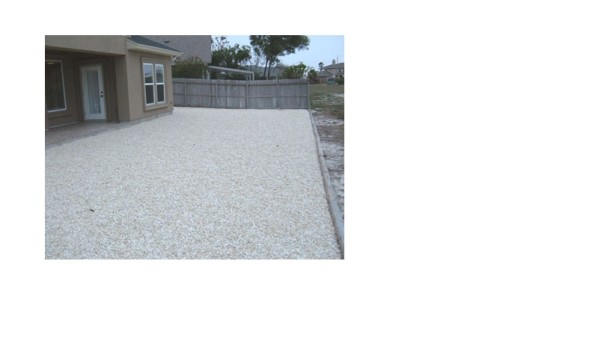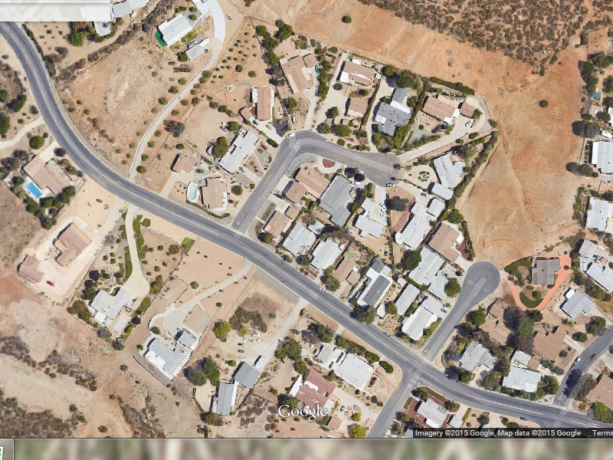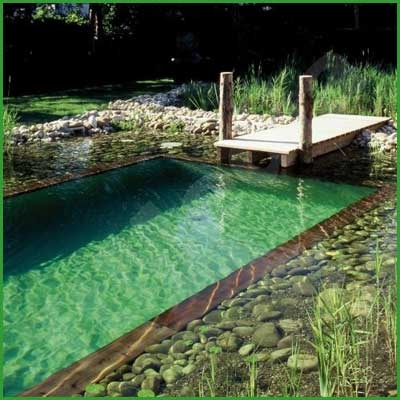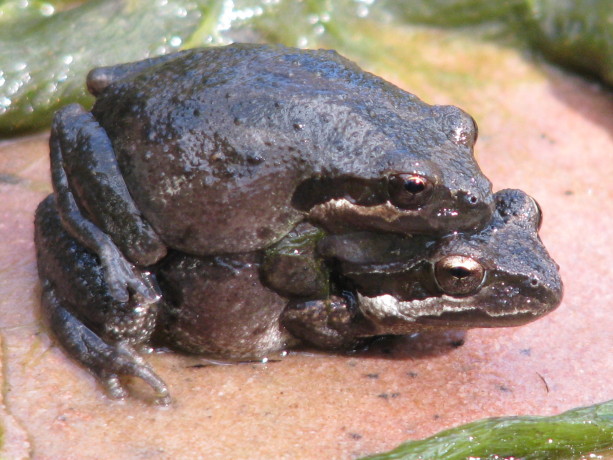My Plea Against Gravel
 Here in Southern California, as in many other areas, we are finally legally recognizing the drought. There are rebates in place for those who take out their lawns, and here in Fallbrook there is a 36% water reduction goal. Many people just don’t know what to do with all that lawn. A very unfortunate continuing trend is to dump half a ton of colored gravel on it. Please! NO! First of all, once down gravel is nearly impossible to get out again. Gravel, like all rocks, is thermal mass. Instead of having a large rock heating up and radiating out heat, with gravel there are tens of thousands of surfaces radiating out heat and reflecting light and heat back up. It is the worst kind of hardscape. All that reflected heat and light heats up your home, making you use your air conditioner more frequently which is a waste of energy, and also dries out the air around your home. Desertification reflects light and heat to a point where moist air moving over a region dries up. There is less rain, or no rain. Most trees and plants trap humidity under their leaves. Gravel reflects light and heat back up under those leaves and dries them out, sickening your plants and trees. Pollen travels farther on humid air; it can dry out quickly. If you are relying on pollination for good fruit set between trees that are spaced far apart, then having some humidity will increase your chances of success.
Here in Southern California, as in many other areas, we are finally legally recognizing the drought. There are rebates in place for those who take out their lawns, and here in Fallbrook there is a 36% water reduction goal. Many people just don’t know what to do with all that lawn. A very unfortunate continuing trend is to dump half a ton of colored gravel on it. Please! NO! First of all, once down gravel is nearly impossible to get out again. Gravel, like all rocks, is thermal mass. Instead of having a large rock heating up and radiating out heat, with gravel there are tens of thousands of surfaces radiating out heat and reflecting light and heat back up. It is the worst kind of hardscape. All that reflected heat and light heats up your home, making you use your air conditioner more frequently which is a waste of energy, and also dries out the air around your home. Desertification reflects light and heat to a point where moist air moving over a region dries up. There is less rain, or no rain. Most trees and plants trap humidity under their leaves. Gravel reflects light and heat back up under those leaves and dries them out, sickening your plants and trees. Pollen travels farther on humid air; it can dry out quickly. If you are relying on pollination for good fruit set between trees that are spaced far apart, then having some humidity will increase your chances of success.

By laying gravel you are turning soil into rock-hard dirt, because microbial life cannot live closely under it. That robs any plants you have stuck into the gravel of the food they need from the soil, which is opened up through microbial activity. You are adding to the heat value of the hardscape around your house causing you to cook in the summer and use more air conditioning. You have reduced habitat to zero. You have added to global warming by reflecting more heat and light into the sky. Although gravel is permeable, usually the ground below it bakes so hard that rain doesn’t percolate. I’ve read sites that want to you increase the albedo effect by laying gravel. In the short term albedo helps cool the atmosphere, but as a result of too much reflected light dries everything out. Think of the dark coolness and dampness of forests… that are now bare ground.
What do you do with your lawn instead? There are many choices that are so much better for the earth and your quality of life. First step, cut swales on contour on any slopes for best rain harvesting. Flat lawn? Easier still. Turn your lawn into a beautifully landscaped lush native garden. I’m not talking about a cactus here and there, but a creation with the awesome native plants we have in Southern California. Some of them such as Fremontia can die with supplemental summer water!

There is a chocolate daisy that smells like chocolate. Oh yes. And how can you not want to plant something called Fairy Duster or Blue-Eyed Grass? A native landscape planted on soil that has been contoured to best catch and hold water, and amended with buried wet wood (hugelkultur), will give much-needed food, water and breeding grounds to countless birds, butterflies, native insects and honeybees.
Or put in a pond. Wait, a pond during a drought? Yes! Ninety-nine percent of California wetlands have been paved over, drained or are unusable. Where are all the animals drinking? Oh, wait, we are in the epicenter of extinction, mostly due to wetlands loss. There are very few animals left that need to drink. Those that are left have to take advantage of chlorinated water in bird baths and swimming pools. The microbially rich and diverse clean, natural water that fed and sustained life is just about gone. So what can you do? If you have a swimming pool, you can convert it either entirely to a pond, or into a natural swimming pool that is cleaned by plants.

Suddenly instead of having this expensive eyesore that you use only a couple of months a year and pour chemicals into year-round, you have a lovely habitat that you want to sit and watch, and even better, swim in safely without turning your hair green or peeling your skin. You don’t need to clean the pool all the time, and you don’t need to put in chemicals. If you are in the San Diego or Los Angeles area, call Dr. Robert Lloyd of PuraVida Aquatics for a consultation and conversion. If you don’t have a pool, then build one that is cleaned by plants and fish. You don’t need a filtration or oxygenation system because the biology does it all. Where do you get the water from to top off your pond?

Connect your pond to a lovely, planted stream that is connected to your laundry water or graywater system. You are buying water every day, so why not compost your water through phytoremediation and have a pond full of great healthy chemical-free water that is wonderful to look at and is an oasis for thirsty animals and insects?
Or install a food forest. With good soil building and rain catchment first, and planting in guilds with sheet mulch around trees and on pathways, you will be using a fraction of the water you pour on your lawn and yet harvest lots of food. Too much food? Share it with a food pantry!
Or start a veggie garden without digging any sod.

Layer cardboard, sticks, grass, food scraps, leaves, more grass, more food scraps, more leaves and top it with about 8 inches of good soil, then plant right in it! That lovely standing compost heap will slowly turn into good soil while killing the grass beneath and growing crops for you immediately.
If ridding yourself of a lawn just breaks your heart, then substitute the high-water use grasses for a native grass mix that is comparable. Look at S&S Seeds for prices or for seed choices. Water a few times with Actively Aerated Compost Tea using any rainwater you may have caught in those 50-gallon containers and your grass roots will travel so deeply that they will find groundwater. Check up on the work of soil microbiologist Dr. Elaine Ingham and see how easy AACT is to make and use.
There are so many alternatives to using gravel that aren’t expensive, that are an investment in your property and in reclaiming habitat while beautifying your home and saving money. So please, just say, “NO,” to the gravel. Tell a friend!!
Which one of these would you rather live in? Which do you think is better for the earth and for the future generations?


14 Comments
Diane
Denise, I very much appreciate your comments and your efforts. We have been spoiled because water has been so cheap and easy to come by, and we wsate so much of it. Most landscapes are overwatered to the detriment of the soil and the plants. Good for you for championing natives! Best of success, Diane
Denise Swift
OMG! Thank you! I’ve been trying to tell folks NOT to put down gravel!! As a San Diegan native living in N. Cali in Chico and owning 32 acres and a home about 10 miles above Lake Oroville for the past 28 years landscaping and drought are my life. I’ve been trying to tell people to NOT put down gravel…the heat is bad enough in hot climes, let alone adding more! Grass and plants cool temps around your home by many degrees. I have an AA degree in Ornamental Hort and Landscape Design and Management from Butte College in Chico…and my ex husband and I had a Landscape Installation biz in Chico (originating in Fallbrook…our hometown) for 25 years. NOW things are changing up on the landscapes in town here. I see start up companies putting in piles of gravels and rock, etc. to take advantage of the changes due to the drought. People want it easy. They don’t spend the time they should or used to outside enjoying their yards. Your landscape photos (I’m also a photographer) are wonderful and such an inspiration! I am going to share this article of yours to everyone I can in the Chico area. I am currently in Palm Springs visiting my mom and have noticed the removal of much of the grass (in progress) with replacement of native plants and (my favorite) ornamental grasses. It really looks lovely. Lantana, Palo Verde, etc…. Also very good examples in Borrego Springs…where I spend time often. I hope you can get your message out there! I will help you in any way I can. Let me know. Sincerely, Denise Swift
Diane
Mandy, great job establishing habitat. In permaculture the problem is the solution, although re-purposing the gravel can be a challenge. At a client’s house we were wondering where to put the gravel from a pathway, and then realized a perfect place would be in a future vernal pool along with rocks of other sizes for a natural look. Or for making cement stepping stones. Or in a cob structure. Thanks for commenting. Diane
Diane
Hi Ronee, I’m so glad that you liked the article. We just had a consultation in Menifee yesterday and drove through myriad streets of gravel yards of various hues. Hopefully the good looks of the future front yard of our client will help change other people’s minds, but often the elderly don’t want any work at all. Some of the photos from the article I gleaned from Google searches, and some I took. The best place to find ideas is in Greg Rubin and Lucy Warren’s book, California Native Landscapes. It is available through the SD County library system, but I own a copy because I use it so much. The authors are San Diegans so they know what works here, not in Northern CA or the east coast. A trip to Tree of Life nursery (off the Ortega Hwy) would be a great resource for you, but give yourself a budget and a plan or else you’ll end up with a ton of plants! Yes, please share the article if it would help change some minds! Best of luck with your lawn conversion, and thank you for wanting to reestablish habitat! Diane
Mandy Barre
I re-purposed the gravel off my old style roof into walkways..works fine and tiny weeds grow within it. Most o the rest of the yard is composted, native and/or succulents- all low water.
Ronee
Excellent article. In total agreement. We are in the process of removing 4600 sq ft of lawn with drought tolerant plants and natural mulch. Can you tell me where you found the picture of the California native plants. Would love to get even more ideas. Mind if I share your article? Wish you could. Get this in the San Diego Union Tribune.
Diane
Hi Kate. Thank you so much for your comment! This is a concern for many gardeners. However I have nothing but faith in the power of microbes. I have a humanure system with an outdoor composting toilet that is used by visitors on tour of Finch Frolic Garden, and the anaerobic microbes in the covered and stored bucket form long-chain carbon molecules that isolate the toxins found in human waste and bind them up, making them inert. There are a lot of very scary things in human waste due to our medicines and toxins we absorb from treated clothing, food and the environment. I have an avocado tree that has sheet mulch around it and is irrigated by well water that is high in minerals, especially salts. Avocado trees develop leaftip burn due to these water contaminates, except for mine. The fungus and bacteria in the soil which are highly active due to the sheet mulch separate these minerals and disperse them so that they don’t burn the tree. If you read or watch anything by Paul Stamets of Fungi Perfecti, or by Dr. Elaine Ingham (soil microbiologist), you might – as I have – develop full faith in the remediation abilities of good soil. Most cardboard is just brown matter. Most inks are soy-based. By the time that the cardboard breaks down the microbes will have decontaminated anything that is harmful. I don’t use cardboard that has plastic in it, or is coated in plastic. I do, however, leave tape on because it is a hassle to remove and it will eventually separate and rise to the top for easy collection. In a lasagna garden you usually put cardboard down as the initial layer to smother the grass, and then build up from there with grass clippings, manure, dry leaves, etc., and then have good compost the top 8 – 10 inches (about as long as a carrot) because annual vegetables only reach that far down. By the time the nitrogen cycles through the other stuff, whatever might be in the cardboard or in the manure will have been remediated. I have no hesitation in using cardboard or newspaper in the garden. Neither does Geoff Lawton or any of the other major permaculturalists that I know of. However everyone’s garden is a reflection of their practices and beliefs. If using cardboard in your garden bothers you… don’t do it! A thick layer of hot manure instead of cardboard should burn the grass and weeds, and you can build up from there. Thanks again for commenting, and best of luck in your garden! Diane
Kate F
Great article, but I’m concerned about growing vegetables in the lasagna garden containing cardboard… It might have unhealthy chemicals/dyes in it…?
k
Diane
Thanks!
Paul Taylor, OCNP
Great article and photos giving people option to a lawn and just gravel. Build biodiversity and your garden will thrive. Have Fun in the Garden!
Diane
Great point! Thanks!
Heather
The other issue with gravel is where it comes from – it is mined from rivers and mountains. Given the environmental costs to extract it, it is a resource that should be used sparingly and only where really needed. Replacing a lawn with gravel is double insult to our natural world.
Diane
Thanks Claudia! People are pulling out lawns and in desperation pouring on the gravel, which is just hastening desertification and extinction. GRRR.
claudia
Excellent post with very compelling reasons and amazing photos!